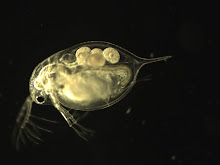
I am standing approximately where the glacier used to be only 30-40 years ago. The Rotmoos Glacier is retreating at a rate of about 30-40 meters per year, with a retreat of as much as 70 m/yr during especially warm years. 70 m !!! That's crazy. In fact, while we were there we watched as a huge chunk of the glacier edge broke off in front of our eyes.
Here's a picture of the 1920 terminal moraine (that small "bump" in the valley, about halfway down the photo):

and here's one of the 1853 moraine (again, the "bump" in the landscape):

The Rotmoos is only one of the countless glaciers all over the globe that are quickly disappearing. Most of us find it quite alarming, but some people may ask "so what?" I mean, yeah, how many of us actually ever visit a glacier? Only us geeky scientists and outdoor enthusiasts. But how many of us actually depend on glaciers? Billions of us. No shit. Glaciers provide water for much of the world, including populous countries like China and India. When the climate warms and glaciers melt, people turn to other water sources, like groundwater, an ultimately non-renewable source in most regions when compared to the rate it is extracted. So yeah, glaciers are pretty important, such that we've even figured out how to tell kids about this.
Here's yet another indication of climate change in alpine regions:

This fake lake was built at 2000 m elevation for snow-making. I can't believe that snow-making is needed at 2000 m elevation! Climate change is influencing (note present tense) a variety of alpine ecosystem services, including ski tourism, an economically important industry in many regions. Another alpine ecosystem service being anthropogenically affected directly by land use alteration and indirectly by climate change is the native, stabilizing vegetation community. What do I mean by "stabilizing"? Many of the herbaceous and shrub vegetation holds the soil in place and prevents or at least mitigates the impacts of mudslides/ landslides, which drastically affect communities who live in alpine valleys. This webpage seems to sum up nicely a lot of things that we learned in this course (though I can't verify the authors' credentials).
Anyway, it was a great course and a great trip, and I hope I gave you some food for thought! See the rest of my pictures from Austria here.

1 comment:
It is remarkable, very valuable idea
Post a Comment